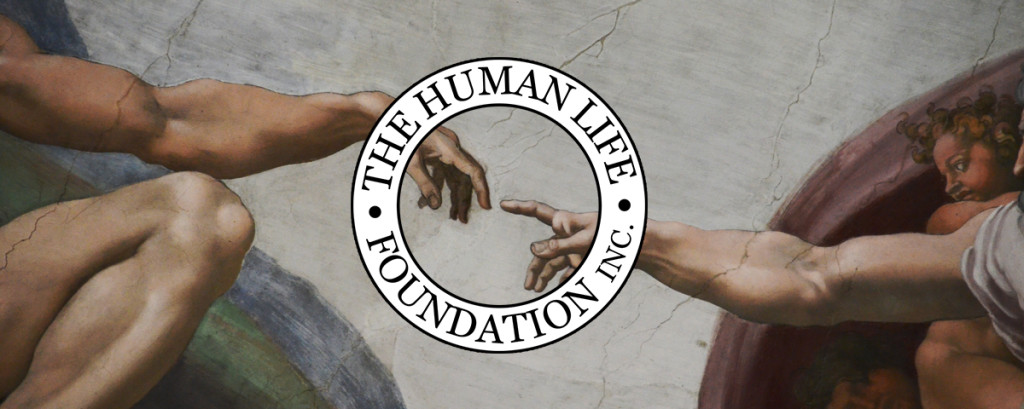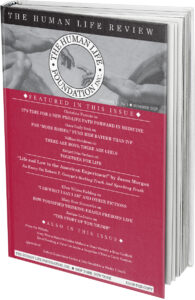The Other AI
Long before Pope Leo XIV spoke of the mixed blessings of artificial intelligence and was named by Time a Top 100 figure on the hot topic, the Catholic Church had expounded on another AI, i.e., artificial insemination.
The two AIs have more in common than might seem at first thought, or shall we say, first concept. Just as artificial insemination (and its adjunct procedure in vitro fertilization) has brought forth a literal brave new world of sexless reproduction and test tube babies, artificial intelligence promises to revolutionize every aspect of our world from home life to work life to how we think and interact—so much so that soon we may not recognize ourselves as uniquely human. And just as artificial intelligence has captured the imagination of our culture and the attention of futurists, policymakers, and regulators, so artificial insemination surprisingly entered the political realm last year when the Trump team announced before the election that not only would the next president keep in vitro fertilization safe, legal, and widespread, he would make it more accessible and affordable; promising, in a sense, to make artificial insemination another form of Open AI.
The policy statements were meant, ironically, to show that Trump was pro-family, pro-child, and pro-woman. Our society has thoroughly embraced artificial reproduction technologies (ARTs); there are few voices publicly pointing out the demonstrated negative effects of in vitro fertilization on women and children, and the attendant disruption of family life when customary marital relations are replaced by “sperm collection” from the woman’s husband or another male with desirable genetic characteristics.
The woman undergoing this procedure is subject to physical risks including the administration of powerful hormones to cause her to hyper-ovulate (producing more than one egg per cycle) followed by the invasive removal of the eggs, which are then placed in a dish and inseminated. The resulting embryos are screened for acceptability and those deemed healthy are implanted in the woman. Many women suffer psychological and spiritual damage as multiple insemination cycles fail to produce a child. Children “conceived” in this way subsequently may suffer from being the product of a lab procedure, rather than a gift generated by a physical act of love between spouses. Meanwhile, many lab-produced embryos are never implanted. Considered “extra,” they are frozen for possible later use, or eventual death when unclaimed.
Just outlining the more obvious and endemic problems with these practices causes my stomach to churn both in anger and nausea: Yuck! Yet these largely unregulated ARTs have been strongly promoted by the medical field and government entities, despite moral, medical, and health dangers. Would that our society had heeded the Catholic Church decades ago.
The landmark Catholic teaching on the subject, Donum Vitae, was promulgated in 1987 by the Congregation for the Doctrine of the Faith, then under Cardinal Joseph Ratzinger, the future Pope Benedict XVI. While admitting the limits of the Church’s competence in the area of “experimental sciences,” the document claims the ability to judge certain procedures on the basis of “the moral teaching corresponding to the dignity of the person and to his or her integral vocation.”
Just a few excerpts will suffice:
“It is immoral to produce human embryos destined to be exploited as disposable ‘biological material’ . . . It is a duty to condemn the particular gravity of the voluntary destruction of human embryos obtained ‘in vitro’ for the sole purpose of research, either by means of artificial insemination of by means of ‘twin fission.’ By acting in this way the researcher usurps the place of God …”
“In consequence of the fact that they have been produced in vitro, those embryos which are not transferred into the body of the mother and are called ‘spare’ are exposed to an absurd fate, with no possibility of their being offered safe means of survival which can be licitly pursued.”
“If, on the other hand, the procedure were to replace the conjugal act, it is morally illicit. Artificial insemination as a substitute for the conjugal act is prohibited by reason of the voluntarily achieved dissociation of the two meanings of the conjugal act.”
Pope John Paul II also addressed these issues in his 1993 encyclical Evangelium Vitae:
“The various techniques of artificial reproduction, which would seem to be at the service of life and which are frequently used with this intention, actually open the door to new threats against life” (14).
These well-informed, prophetic messages on artificial reproduction technologies not only have been ignored by our society, and by many within the Church; they also have been subject to persistent ridicule and dismissed as medieval nonsense from the institution that condemned Galileo.
The Church’s guidance on artificial intelligence, however, because it does not pertain to sex or abortion, has reached open minds seriously concerned about the issue and has been ranked by our cultural elite and influencers as worthy of a hearing.
In a message to participants in the Vatican’s second annual conference on artificial intelligence last June, Pope Leo cited his predecessor’s statement that AI is a tool. He added, “By definition, tools point to the human intelligence that crafted them and draw much of their ethical force from the intentions of the individuals that wield them. In some cases, AI has been used in positive and indeed noble ways to promote greater equality, but there is likewise the possibility of its misuse for selfish gain at the expense of others, or worse, to foment conflict and aggression.”
In contrast to the response to interventions on artificial insemination and other sexual topics, the Church’s contributions on the other AI have been widely appreciated. Yet the same moral calculus underlies how the Church views both topics: the respect due the dignity of the human person made in the image and likeness of God.
Still, it is refreshing, however ironic, to read these words in Time magazine:
“Under Pope Francis, the Vatican had pushed for a binding international treaty on artificial intelligence, sending the world’s tech CEOs into a defensive crouch. If Leo XIV continues to marshal the world’s Catholics against AI’s alienating potential, Silicon Valley faces a formidable—and unexpected—spiritual counterweight.”









